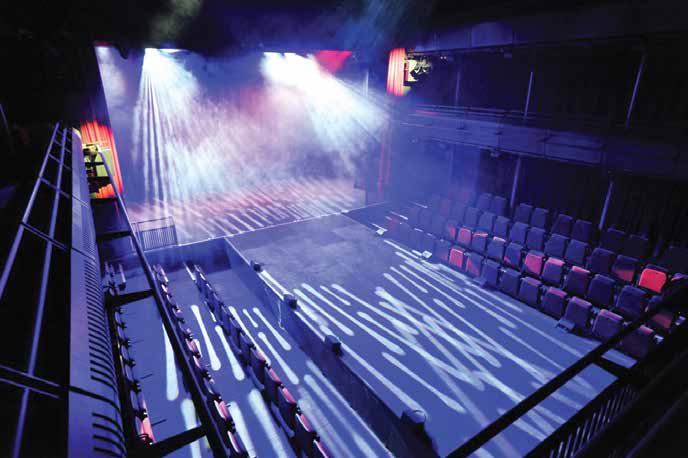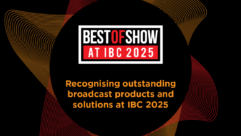

SVC: Let’s start by briefly getting into your company Autograph Sales & Installations and the projects you do there.
Euan Mackenzie: We’re an audio integrator based in West London. We handle our clients from consultation to installation. We also pride ourselves on the training and backup support that we provide. We’ve got a sister company called Autograph Sound Recording, a hire company, so we’ve got a wealth of backup equipment should anything happen to go wrong with any of our clients. Most of our clients would be across London, but there are many further afield throughout the U.K. We had recent projects in Perth in the north of Scotland, for example, and obviously up in Manchester as well, for the Adelphi Theater.
It’s a very new building and the pictures of it are impressive so I’m sure it was an exciting job getting to work in there.
Yeah, absolutely. It was something a little bit different, when it comes to the varied orientations of the theater. It’s not just a traditional end-firing system. It needs to cope with many different types of theater. The new Adelphi Building is part of the University of Salford and it’s their new home for the School of Arts and Media. We did the installation for the main theater space, which helps in courses and theater performance, music and dance. The intention of that is to host more and more music and dances as well as larger-scale musical theater productions and fashion shows.
I would guess that you got involved in this project at a very early stage in order to make all of this work for a theater capable of so many different seating configurations.
Yeah, that’s right. My first visit to the theater was while it was still a building site with contractors everywhere, hi-vis vests and steel-cap boots. The grids in the balcony and circle fronts were in, but there wasn’t a lot else there. We were working with or were aware of the consultants for the theater at that stage; they were Theatreplan, so we knew they were in good hands. They built up the overall design and specification for the theater, but the university technical team separated out the theater PA so that they could have a more hands-on approval and they could have talks with suppliers and installers directly. They knew at the university at an early stage that turning the theater orientation around show by show would be a pretty tall order. So they needed to ensure that they could do all of this as quickly as possible. There’s no easy way to move around steel decking and seating banks, but at least we were able to make their workload a little bit easier with the PA.
Since there are classrooms and quiet spaces nearby, did you need to do any sort of extensive acoustic treatment of the theater?
That was contracted out to other businesses via Theatreplan. So we came in and we dressed in the PA, and time-aligned and commissioned that. But overall yeah, the acoustics were very well-controlled in the room once everything was in. That’s just one of the joys of working with a new build and a specialized theatre consultant being involved. For example, the walls were acoustically treated with diffusion material and they also had drapes that could be pulled or drawn along the side walls so they could change the acoustics to suit each show. It’s a nice, simple, but effective way of doing so. But we found no major audio gremlins during commissioning. It’s a 350-seat capacity and with the circle and balcony levels it’s quite an intimate feel. I think the main left and right hangs are only throwing about 10 meters forward.
And I’m sure that one of the biggest challenges on this was the fact that it can be configured as a thrust stage, in the round and several other things.
There are five main layouts for the theatre. So there’s your traditional end-firing or proscenium setup. There is thrust stage. There is long traverse or catwalk style traverse. A short traverse, which is perpendicular to the long— so 90 degrees on that—and in the round. So there are some scenarios where you’re seating on the stage that we have to cover and others not; some where there are side delays that you have to cover under balconies, and then sometimes not. So yeah, we had to have something that could be configured at the drop of a dime and the technical team were pushing for the fact that they did not want to re-rig any speakers whatsoever. So we had to make sure that every seat was covered.

That need for versatility must have been one of the reasons you selected the DiGiCo SD9 mixer.
Yeah, absolutely. In a space like this the console has to be very flexible. So yeah, the ability to change system structure during preproduction, for example, is something that’s very helpful to have. And with the DiGiCo, if you need more auxes you just dial them into your system structure and you’re away. The SD9 specifically was chosen because it’s got a small footprint. The ability to get that many channels in a small space is very helpful. And also the ability to upgrade the desk to theatre-specific software for musical theater, which is going to be one of their focuses moving forward is a big advantage. Not all of the DiGiCos have the ability to go to the theatrespecific software, but it certainly makes it a lot quicker and easier to preprogram a desk. Since the time that the console was specified and even installed initially, DiGiCo released the new Stealth Core 2 software, which has basically doubled the capacity of the desk. So the desk itself, the input count has gone from 48 inputs to 96 and the amount of groups or auxes has gone from 12 to 24.
That’s got to come in very handy with the flexible seating and the wide range of events they have in there. Another central part of that necessary versatility would be the QSC digital signal processing, so how is that set up?
Yeah, absolutely. That’s really what helped us do the smart stuff and make things as simple as possible. So we’re using the Q-SYS DSP for routing, level, delay, room EQ and input limiting the amplifiers. The IO for the main PA is all transported over Dante and we also used an additional 8-in, 8-out analog audio for the surround sound speakers, which are used for spot effects and cinema system. There’s a dedicated touchscreen in the control room, which allows for status monitoring of the DSP and Dante. They can also mute to the balcony speakers if there’s nobody seated up there, if the seats haven’t been sold, so they’re not adding additional excitement to the room using speakers that don’t need to be on. And of course they can choose the seating orientation at the push of a button from the touchscreen. And finally there’s also a dedicated cinema mode which can be commissioned for them as well, which re-times all of the surround sound speakers and allows for a more consolidated center array of speakers rather than front fills across the stage.
That’s an amazing range of different things to have to cover and make sound right. Maybe all the way from a panel discussion where you want no reverberation and need speech clarity all the way to something like a big choir where you want them to sound reverberant and just very big.
Absolutely, yeah. I mean the open architecture of the Q-SYS DSP really lets us, and the sound designers, do what they want. We’ve put in a signal chain, which includes everything that they might need, as mentioned before. And we’ve popped in a dedicated Wi-Fi network to allow the sound designers or the technical team to reconfigure the DSP to suit each show from anywhere in the auditorium. And as a backup, if anything should go wrong that’s out of the hands of the in-house technical team, we’ve got remote access over the Internet to monitor any faults or to reprogram anything that’s a little bit more intricate.
And of course everything there has to start with the microphones so what did you use?
We used Sennheiser’s 500 series radio microphones, which is a must for technical theater particularly with the lavalier microphones. For their larger musical productions, they have a wealth of MKE 2 Golds and for more technical speeches, talks, and lectures they use the ME 4 microphones. They’ve also got a few handhelds which are the large diaphragm condenser microphone heads, the 965s. I think they went to the 500s because they’ve got some existing Sennheiser radio systems and they want this to compliment what they already had. And also being where they are, they’re not in the middle of media city. They’re not vying for RF positioning. They don’t have to worry about UHF congestion and analog radio mics are going to be able to do the job, particularly the 500 series from Sennheiser. They’re very nice-sounding radio mics.
I noticed that you used the EM Acoustics amps and speakers on this new system. What were the attractive points of those?
I’m not sure how well known EM Acoustics is in your neck of the woods, but they’ve certainly been making waves over here in recent years. We’ve had a lot of experience with EM Acoustics because they fit very well into theatre – musical theatre. The beauty is they sound great straight out of the box and the speakers within the range complement each other. So you can put a box that fits to suit the dispersion of where it needs to be and be sure that it will marry up nicely with the others in the range. It’s called EM because it’s Ed and Mike who are the guys who created it – and Ed’s passive crossovers, there’s something special there. It’s a bit of a work of art. Nice analog crossovers inside each of the speakers. The price certainly plays a determining factor although I’m not sure how we quite managed to install 60 speakers into the theatre and remain within budget, but we did. To give you an idea of how good they sounded we only needed to take 4dB off at 580Hz and that’s from the installed left and right speakers only. The rest of the system was left with the factory presets excluding the high-pass filters and sub EQ. They really are pretty good out of the box. Sixty speakers might sound a little excessive, but not all the speakers are used for all seating layouts. So in addition to the proscenium system we needed to cover all three sides of the under balcony on all three levels, so when the system is switched to in the round for a production of Hamlet, for example, every seat is still covered. We also snuck in additional side fills which were tucked in behind the main left and right speakers for when seats are on stage. And we also made those available as stage fills for when there’s no seats on the stage; another benefit of the Q-SYS system.

I would think that with such a wide variance of seating arrangements, that having a lot of speakers would give you the control you need. It really doesn’t sound excessive to me. I’m thinking it would be great to have that.
It’s more about coverage and even amplitude and frequency across the venue. So there’s a limit to how many speakers you can put in before you start introducing more artifacts with time alignment issues and making your job harder than it needs to be. But being able to mute the speakers that we don’t need and reconfigure the delay within a snapshot makes everything very, very simple.
I was going to ask what’s involved in going from one of these seating arrangements to something completely different but it sounds like just pushing a few buttons and making a few adjustments and you’re there.
Yeah, absolutely. Like I said, the touch screen is in the control room – so from an end user’s point of view there’s not a lot to do, at least audio-wise. They select the seating layout that they want to use on the touch screen. We configured a 24 x 40 crosspoint matrix as in Q-SYS. That does a lot of the legwork. And we’ve also programmed in the required speaker mutes, delay settings within the same snapshot as that matrix so it is really just done with the touch of a button.
And that probably makes training on the system a whole lot easier.
It does to a certain point. I mean the guys at the venue weren’t that familiar with Q-SYS when we first went in, but we like to make sure that they can hit the ground running; we’ve already taken them through basic Q-SYS training on site and training is ongoing as well. So the technical team will be completing, if they haven’t already, the online Q-SYS training from QSC Direct, which is a great base of training that you can log in and do online. It’s done extremely well. We do in-house training with DiGiCo consoles. We’ve got half a dozen of them set up in our training room and a couple of times a month we have a load of people in to learn the consoles and how they work. So we took that same training exercise up to Salford to train the team onsite and we’re going to return again once they’ve completed their first run of shows with some more specific training to their venue.
And you’ve got the DiGiCo Orange Box working with that. What specific configuration do you have that in? What type of internal cards are you using?
We’re going B and C MADI in and then out on Dante. Nice and simple. It just basically puts the SD9 on the Dante world and then via the switch network it goes into the DSP and then into the amps as well. The amplifiers have got Dante cards built in.
Alright so it sounds like everything is configured the way it should be for such a wide variety of formats and seating layouts. How much time did they give you to get in there, get all this stuff done and have it ready for the first demo?
I think we got off lightly with our installation. I think the building contractor had a steeper hill to climb. But we split our install into two chunks. We were up there for a week to get the end firing system in place and commissioned. We also took that opportunity to fly all of the delay speakers for the other seating scenarios as well. We then returned a few months later when the team were ready to turn the seating orientations around and we commissioned the other four seating layouts. They also threw a little curveball at us where they asked us to tie in surround speakers, which we didn’t install. That was done by another contractor – but they wanted to have those available on the main system both for cinema showing and also for the spot effects for their plays and their musicals. So that’s why we’ve got the analog cards in the back of the Q-SYS to get 16 channels to the analog amplifiers.
Now that you’ve got this one in the resume and down in the books, what have you got coming up for Autograph Sales and Installations?
There’s quite a bit. We’re very busy at the moment. We usually expect a natural surge of installations at the end of summer, so September or August vary. We seem to be steadily growing for the past four years and this year has been no exception to that rule. So one particular installation that we have coming up is the Haymarket Theater in Leicester. It’s currently undergoing a £3 million restoration following a 10-year closure. We’re supplying the front of house PA, which includes multiple DiGiCo desks, and a D&B PA system. We’re also doing the paging and the comm systems there as well.










